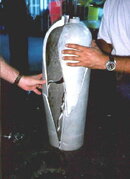captain
Contributor
So if the hydro strain is permanent...we gain some tank capacity with each hydro? Some of tanks I've seen should be quite a bit bigger than they started out.
If you are capable of seeing an increase in capacity measured in cubic centimeters you should never have need for a tape measure. Those would be some incredibly calibrated eyeballs.





